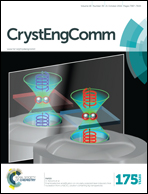Three novel metal–organic frameworks based on an unsymmetrical rigid carboxylate ligand for luminescence sensing of nitrobenzene derivatives and magnetic properties†
Abstract
Three novel metal–organic frameworks, formulated as [Co(HDCPN)(4,4′-bibp)]·1.5H2O (1), [Cd3(DCPN)2(4,4′-bibp)2H2O]·1.5H2O (2) and [Mn3(DCPN)2(4,4′-bibp)3(H2O)4] (3) (H3DCPN = 6-(3,5-dicarboxylphenyl)nicotinic acid and 4,4′-bibp = 4,4′-bis(imidazolyl)biphenyl), have been solvothermally synthesized based on an unsymmetrical rigid carboxylate ligand. Single-crystal X-ray diffraction analysis shows that complex 1 is an sql/Shubnikov tetragonal plane network with mononuclear Co(II) ions, which is connected by O2⋯H2⋯O1 hydrogen bonds to generate a 3D framework. Complex 2 is a new 3D (3,10)-c network based on trinuclear Cd clusters. Complex 3 is an extended 3D (3,10)-c network based on trinuclear Mn clusters, which belongs to 3,10T3 (MOF.ttd). Complex 2 exhibits potential application for the luminescence sensing of nitrobenzene derivatives. Furthermore, the variable-temperature magnetic susceptibilities of complexes 1 and 3 indicate that they exhibit antiferromagnetic behavior and ferromagnetic behavior between metal ions, respectively.


 Please wait while we load your content...
Please wait while we load your content...